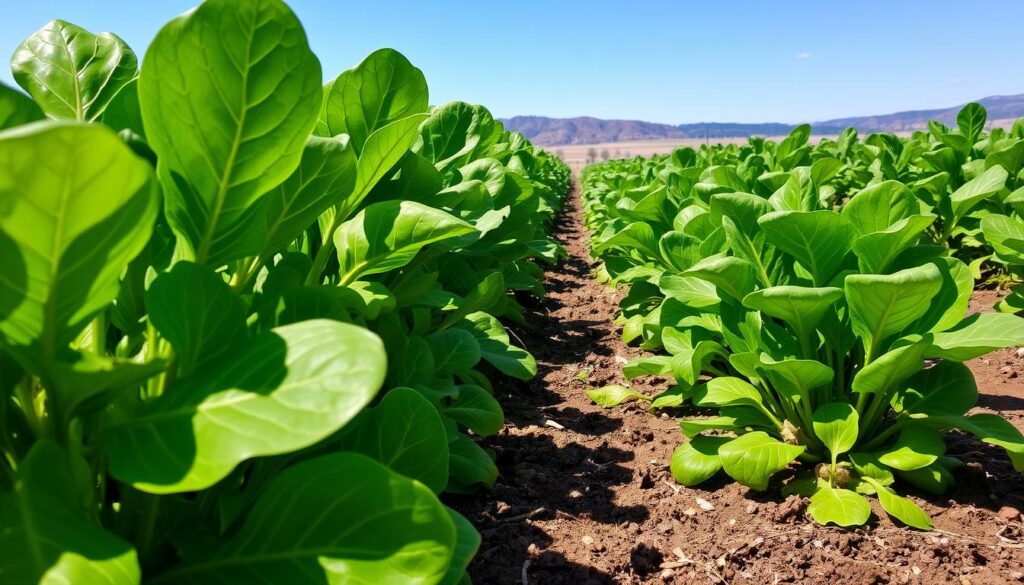Welcome to our guide on growing spinach. We’ll show you how to grow spinach from seed to harvest. Knowing the spinach growing season is key for a good harvest. We’ll cover the basics and give you the skills to grow tasty and healthy spinach.
Learning to grow spinach is rewarding. With the right methods, you can have a lot of spinach. The season for growing spinach starts in early spring or late summer. With the right care, you can have spinach all year.
Our guide is for both new and experienced gardeners. We’ll tell you everything from preparing the soil to harvesting. We’ll also share tips for growing spinach during the best season.
Introduction to Spinach Growing
In this section, we covered the basics of growing spinach and why knowing the growing season is important. Now, let’s look at the main points from this section.
Key Takeaways
- Understanding the spinach growing season is key for a good harvest
- Learning to grow spinach is rewarding
- The growing season starts in early spring or late summer
- Good care can make the season longer
- Our guide will help you grow spinach successfully
- Preparing the soil is vital for spinach
- Harvesting spinach at the right time is important for flavor and nutrition
Understanding Spinach Varieties and Their Growing Requirements
Choosing the right spinach variety is key to a great harvest. There are many types of spinach, each with its own needs. Knowing the differences helps you pick the best one. Follow spinach planting tips and a spinach care guide to make your spinach plants thrive.
Spinach comes in three main types: smooth-leaf, savoy, and semi-savoy hybrids. Smooth-leaf spinach has flat leaves, great for salads. Savoy spinach has curly leaves, perfect for cooking. Semi-savoy hybrids have slightly curly leaves and a milder taste.
Smooth-Leaf Spinach Types
Smooth-leaf spinach is best for salads and fresh dishes. It grows quickly, ready in 20 days. ‘Space’ and ‘Tyee’ are popular varieties.
Savoy Spinach Varieties
Savoy spinach is great for cooked meals like sautés and soups. It tastes stronger than smooth-leaf and is ready in 30 days. ‘Bloomsdale’ and ‘Merlo Nero’ are favorites.
Semi-Savoy Hybrids
Semi-savoy hybrids have the best of both worlds. They have slightly curly leaves and a milder taste. They grow easily and are ready in 25 days. ‘Olympia’ and ‘Tiger’ are well-liked.
Knowing the different spinach types and their needs helps you choose the right one. Follow spinach planting tips and a spinach care guide for a successful harvest.
| Variety | Days to Harvest | Leaf Type |
|---|---|---|
| Smooth-Leaf | 20 | Flat, smooth |
| Savoy | 30 | Curly, wrinkled |
| Semi-Savoy Hybrid | 25 | Slightly curly |
Best Growing Seasons for Spinach Success
Spinach loves the cooler weather of spring and fall. Knowing the spinach growing season is key for a good harvest. It grows best when the temperature is between 40°F to 70°F (4°C to 21°C).
This makes it perfect for planting in early spring or late summer. For those into container gardening, spinach is a great choice. In organic spinach farming, using natural pest control is important.
Some benefits of organic spinach farming include:
- Improved soil health
- Increased crop yields
- Reduced environmental impact
By knowing when to plant spinach and using organic spinach farming methods, you can grow healthy spinach. With the right care, you’ll have fresh spinach for salads, smoothies, and more.
How to Grow Spinach: Essential Steps for Beginners
Growing spinach indoors can be very rewarding. With the right techniques and tools, you can have fresh spinach leaves all the time. First, learn the basics of growing spinach and why it’s good to grow it indoors.
Choosing the right seeds is key when growing spinach indoors. Look for seeds made for indoor growing and have a high success rate. ‘Space’ and ‘Tyee’ are good choices because they grow well indoors and don’t bolt easily.
Selecting Quality Seeds
Preparing your growing space is also important. Make sure your containers drain well and use a good potting mix. Spinach likes soil that’s slightly acidic to neutral, between 6.0 and 7.0 pH.
Preparing Your Growing Area
Spinach needs light, water, and nutrients to grow. It likes cooler temperatures, between 60-70°F (15-21°C). When growing indoors, give it enough light from a sunny window or grow lights. With the right care, you’ll get a lot of tasty spinach.
- Lighting: Provide 12-14 hours of light per day
- Watering: Keep the soil consistently moist but not waterlogged
- Temperature: Maintain a temperature range of 60-70°F (15-21°C)
By following these steps and tips, you can grow spinach indoors successfully. It’s a great way to enjoy this healthy green, whether you’re new to gardening or not.
Selecting and Preparing the Perfect Soil
Soil quality is key for growing spinach. It should be rich in organic matter, have a pH of 6.0 to 7.0, and drain well. This prevents waterlogged soil and keeps spinach healthy.
To start, add compost or well-rotted manure to the soil. This boosts its structure and water retention. It also adds nutrients. Use a soil test kit to check the pH level and adjust it if needed.
Soil Preparation Tips
- Test the pH level of your soil and adjust it if necessary
- Add organic matter such as compost or well-rotted manure to improve soil structure and fertility
- Ensure good drainage to prevent waterlogged soil and reduce the risk of spinach pests and diseases
By following these tips, you can create a great environment for spinach. Keep an eye out for pests and diseases. With the right soil and care, you’ll enjoy a rich harvest of spinach.
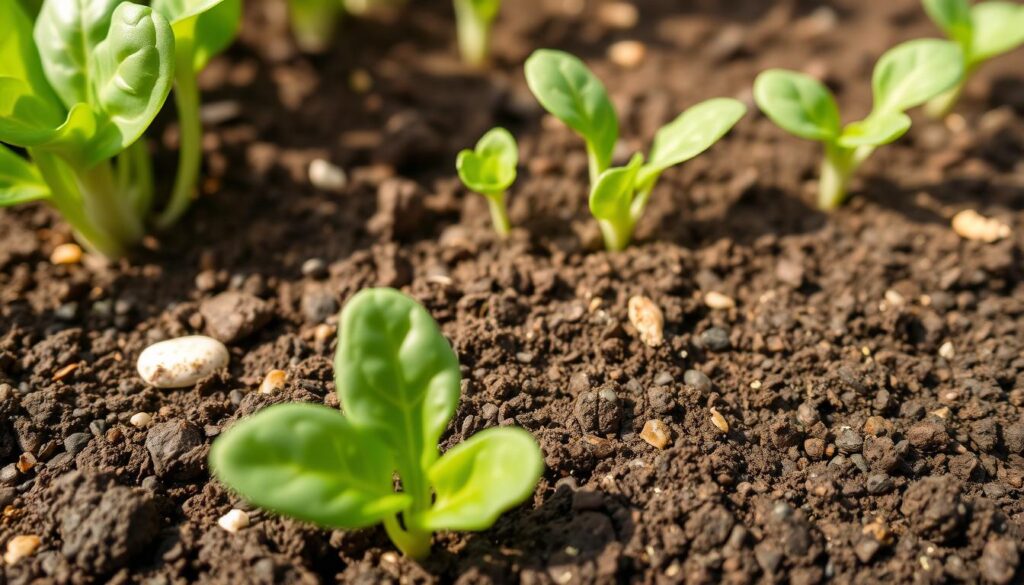
| Soil Type | pH Level | Organic Matter |
|---|---|---|
| Clay | 6.0-7.0 | High |
| Sandy | 6.0-7.0 | Low |
| Loam | 6.0-7.0 | Medium |
Direct Sowing vs. Starting Indoors
Choosing between direct sowing and starting indoors is key for spinach. Direct sowing gets you started early, with quicker growth. Starting indoors gives you control over the growing environment, leading to healthier plants.
For indoor spinach, the right conditions are vital. Use a good potting mix, keep the temperature steady, and ensure enough light. Growing indoors means constant production, fewer pests, and better quality spinach.
Here are some key considerations for direct sowing vs. starting indoors:
- Soil temperature: Direct sowing needs warmer soil, while starting indoors lets you control it.
- Moisture: Direct sowing faces more moisture changes, while indoors stays consistent.
- Lighting: Indoor spinach needs good light, while direct sowing uses natural sunlight.
Think about these points and follow good spinach planting tips. This way, you can decide between direct sowing or starting indoors. With the right choice, you’ll get a great harvest of tasty spinach.
| Method | Advantages | Disadvantages |
|---|---|---|
| Direct Sowing | Quicker germination, easier establishment | More susceptible to moisture fluctuations, pests, and diseases |
| Starting Indoors | More control over growing conditions, healthier seedlings | Requires more equipment and maintenance, can be more expensive |
Growing Spinach Indoors Year-Round
Growing spinach indoors is a fantastic way to enjoy this healthy food all year. You can pick fresh spinach leaves in just 20 days. To start, you need to know the basics of growing spinach indoors and follow a good spinach care guide.
Here are some important things to think about when growing spinach indoors:
- Container selection: Pick a container that’s at least 6-8 inches deep for good root growth.
- Lighting requirements: Spinach needs bright, indirect light to grow well. Put your container near a sunny window or use grow lights.
- Temperature control: Spinach does best in cooler temperatures, between 60-70°F (15-21°C).
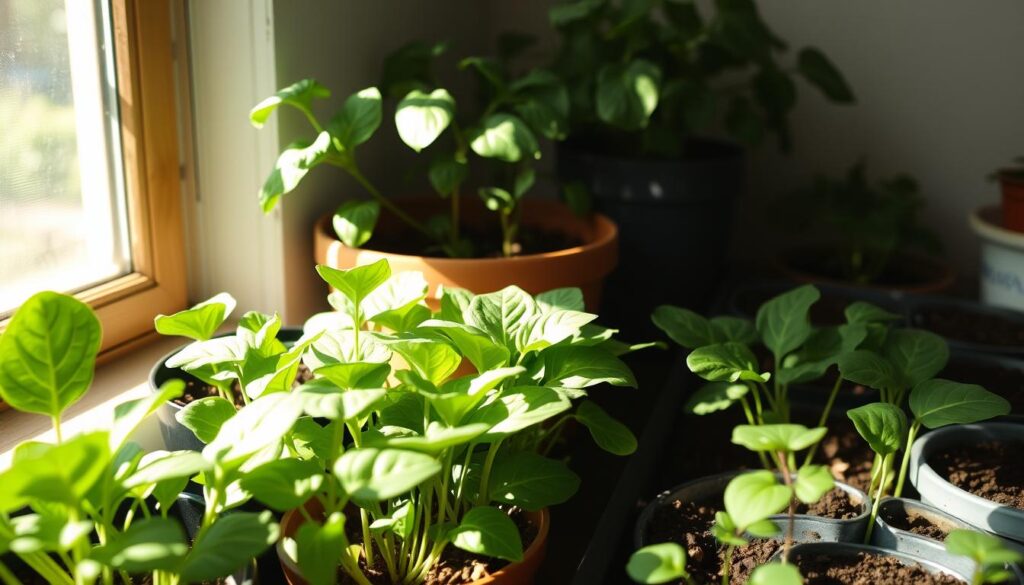
By following these tips and using a detailed spinach care guide, you can have plenty of fresh spinach leaves all year. This is true whether you’re growing spinach indoors on a windowsill or in a greenhouse.
| Factor | Requirement |
|---|---|
| Container depth | 6-8 inches |
| Lighting | Bright, indirect light |
| Temperature | 60-70°F (15-21°C) |
Outdoor Planting Techniques and Spacing
Outdoor planting of spinach requires careful techniques for a healthy crop. Spacing between plants is key. It ensures good air flow, preventing diseases and promoting growth.
The right soil is also vital for spinach. It should drain well and be rich in organic matter. To improve your soil, add compost or well-rotted manure. Here are some tips for outdoor planting:
- Plant spinach seeds 2-3 inches apart and 1/4 inch deep in well-draining soil.
- Use raised beds or containers to improve soil drainage and temperature control.
- Keep the soil consistently moist, but not waterlogged, to promote healthy growth.
By following these tips and using the right spinach cultivation techniques, you can create an ideal environment for your spinach plants to thrive. Remember to choose the best soil for spinach and provide your plants with the right amount of care and attention.
Essential Watering and Fertilizing Guidelines
Watering and fertilizing are key for spinach to grow well. Organic farming uses natural methods to keep pests and diseases away. Too much water can cause root rot, while too little can stress the plants.
Water Requirements
Spinach needs steady moisture, more so when it’s leafy. The right watering schedule depends on weather, soil, and growth stage. Spinach usually needs 1-2 inches of water weekly.
Fertilizer Types and Application
Organic fertilizers like compost or manure are great for spinach. They release nutrients slowly, avoiding root burns. Choose a balanced fertilizer with nitrogen, phosphorus, and potassium.
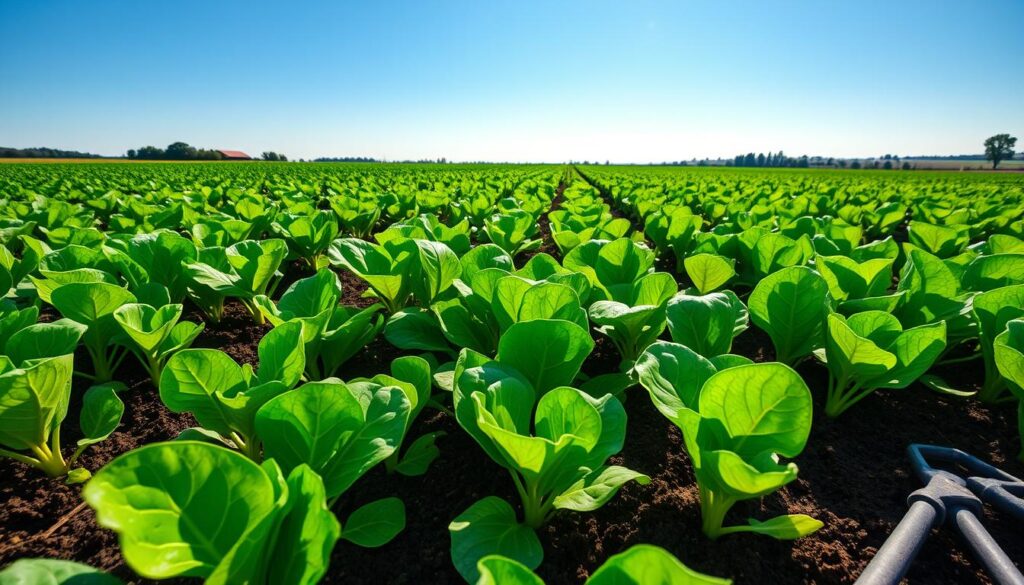
By following these guidelines, you can avoid pests and diseases. This way, you’ll get a big harvest from your organic spinach farming.
| Fertilizer Type | Application Rate | Frequency |
|---|---|---|
| Compost | 2-3 inches | Once a month |
| Well-rotted manure | 1-2 inches | Every 2 weeks |
Managing Pests and Diseases
Spinach is a nutritious and delicious addition to any meal. But, it can be vulnerable to spinach pests and diseases. To keep your spinach plants healthy, following a spinach care guide is key. It should include tips on managing pests and diseases.
Regular monitoring and maintenance are vital. They help prevent infestations and infections. This way, your spinach plants can stay healthy and thrive.
Some common spinach pests and diseases include aphids, whiteflies, and powdery mildew. To tackle these, organic methods are best. Introducing beneficial insects, practicing good hygiene, and using neem oil are effective. A detailed spinach care guide will give you the info you need.
- Inspect your plants regularly for signs of infestation or infection
- Use organic methods to control pests and diseases
- Practice good hygiene and sanitation to prevent the spread of disease
By following these tips and using a thorough spinach care guide, you can keep your spinach plants healthy. And, you’ll enjoy a bountiful harvest.
Companion Planting with Spinach
Companion planting makes your garden diverse and thriving. Some plants are better friends for spinach than others. It’s key to pick the right ones, whether you’re growing spinach indoors or outdoors.
Knowing which plants to pair with spinach boosts its health and growth. This is true, even more so during the spinach growing season. The right friends can keep pests away and improve the soil.
Best Plant Companions
- Radishes: Repel cucumber beetles, which can spread bacterial wilt and other diseases.
- Marigolds: Deter nematodes, whiteflies, and other pests that target spinach.
- Chives: Improve spinach’s flavor and repel aphids.
Plants to Avoid
Some plants don’t get along with spinach and can harm its growth. They might attract pests too. By picking the right friends and avoiding the wrong ones, you can make a great home for your spinach. This is true for both indoor and outdoor gardens during the spinach growing season.
| Plant | Reason to Avoid |
|---|---|
| Beets | Can compete with spinach for water and nutrients. |
| Onions | Can stunt spinach growth and reduce its flavor. |
Harvesting Your Spinach Correctly
Timing is key when it comes to harvesting spinach leaves. Spinach is ready to pick in 20-30 days, depending on the type and spinach cultivation techniques. It’s important to pick your spinach at the perfect time for a good harvest.
Here are some tips for harvesting your spinach:
- Harvest individual leaves or stems as needed
- Use scissors to cut off the leaves, leaving about an inch of stem intact
- Harvest in the morning, after the dew has dried but before the heat of the day
By following these tips and using proper spinach cultivation techniques, you can enjoy a continuous harvest of fresh, delicious spinach leaves. Always handle your spinach plants gently to avoid damaging the leaves or stems. Also, harvest your spinach regularly to encourage new growth.
With proper care and attention, your spinach plants will provide you with a bountiful harvest of nutritious and delicious leaves. All your efforts in harvesting spinach leaves and spinach cultivation techniques will be well worth it.
| Spinach Variety | Days to Harvest | Harvest Method |
|---|---|---|
| Smooth-Leaf | 20-25 | Individual leaves or stems |
| Savoy | 25-30 | Entire plant or individual leaves |
Storage and Preservation Methods
After you harvest your spinach, it’s key to store and preserve it right. This keeps it fresh and full of nutrients. For those growing organic spinach, knowing how to store and preserve is vital. A good spinach care guide should offer tips on these steps.
There are a few ways to store and preserve spinach, like refrigeration, freezing, and dehydration. Each method has its own good points and downsides. The choice depends on what you like and how you plan to use the spinach.
Refrigeration Tips
- Store spinach in a sealed container or plastic bag to keep humidity in and prevent moisture loss.
- Keep the spinach away from strong-smelling foods, as it can easily pick up odors.
- Use the spinach within a few days of storage, as it can wilt and lose its nutritional value.
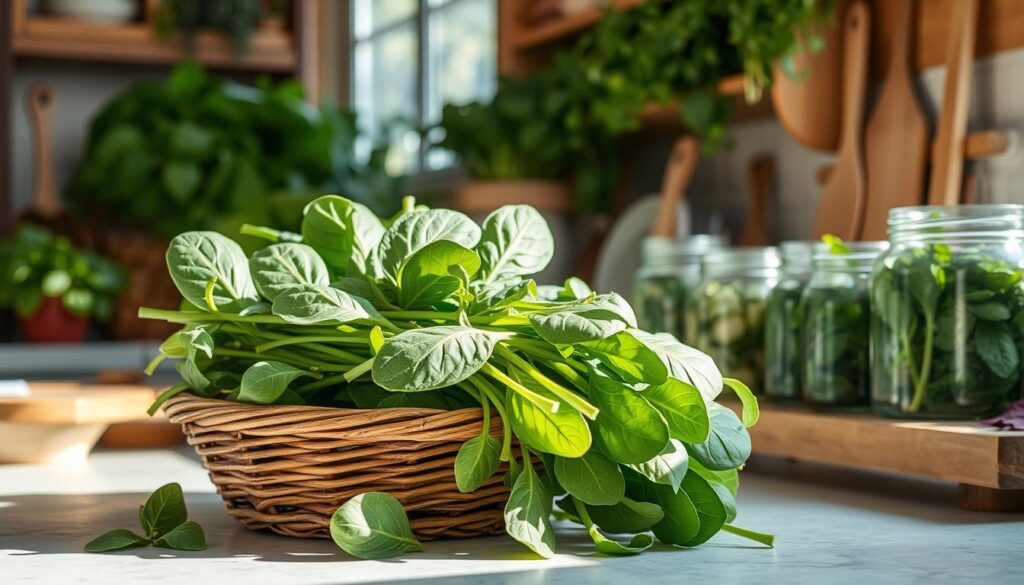
Freezing Techniques
Freezing is a great way to keep spinach fresh, as it keeps its nutrients and texture. To freeze spinach, blanch it in boiling water, then cool it in an ice bath before freezing.
Dehydration Options
Dehydration is another way to keep spinach, and it’s great for making spinach powder or dried leaves. To dehydrate spinach, spread it out on a baking sheet and dry it in a low-temperature oven or a food dehydrator.
Troubleshooting Common Growing Problems
When growing spinach, spinach pests and diseases can be a big problem. During the spinach growing season, watch out for common issues. Aphids, whiteflies, and leaf miners can harm your spinach plants.
To solve these problems, it’s important to know the causes and prevent them. Here are some tips to help you:
- Keep your spinach plants healthy by giving them enough water, nutrients, and sunlight.
- Use natural pest control, like beneficial insects or neem oil, to fight off spinach pests and diseases.
- Check your plants often for disease or pests. Act fast if you see any problems.
By following these tips and watching for problems during the spinach growing season, you can have a healthy harvest. Stay alert and act quickly if you notice any issues with your spinach plants.
Tips for Continuous Spinach Production
To keep spinach coming all year, you need a few key strategies. Growing spinach indoors is a top choice. It lets you control the temperature, light, and water. Using hydroponics or container gardening can give you a steady spinach supply.
Succession Planting
Succession planting means planting seeds often for a never-ending harvest. It’s great for indoor spinach, keeping plants from getting too crowded.
Season Extension Methods
Methods like cold frames or row covers can extend spinach season. They protect plants from harsh weather, letting you grow spinach all year, indoors or outdoors.
Year-Round Growing Strategies
For spinach all year, mix spinach cultivation techniques like succession planting and season extension. Adding indoor growing can make your spinach harvest continuous.
Conclusion: Growing Your Own Nutritious Spinach
As you’ve learned in this spinach growing guide, growing spinach is rewarding. You can grow fresh, tasty spinach in your garden or indoor space. Just follow the steps and tips here.
For successful spinach care, know what each variety needs. Make sure the soil is right and water and fertilize well. With effort, you’ll enjoy your own homegrown spinach in your meals.
Whether you’re new to gardening or experienced, growing spinach is fun. This spinach care guide will help you grow a healthy crop. You’ll get to enjoy the many health benefits of spinach.
FAQ
What are the different types of spinach varieties and their growing requirements?
Spinach comes in three main types: smooth-leaf, savoy, and semi-savoy hybrids. Each type has its own look and growing needs. Smooth-leaf spinach is easy to grow and common. Savoy spinach has crinkled leaves. Semi-savoy hybrids mix the best of both.
Knowing the differences is key to growing spinach well.
What is the best growing season for spinach?
Spinach loves cool weather, best in spring and fall. It grows well when it’s not too hot or cold. In some places, you can grow it all year, but spring and fall are the best times.
How do I prepare the soil for growing spinach?
Spinach needs well-drained, rich soil that’s slightly acidic. Add compost or aged manure to improve it. Spinach also needs steady moisture to prevent root rot.
Should I direct sow spinach seeds or start them indoors?
Direct sowing is simpler and can start earlier. Starting seeds indoors gives you a head start. Choose based on your climate, space, and preference.
How do I properly water and fertilize my spinach plants?
Spinach needs regular water, but avoid wet leaves to prevent disease. Use a balanced, slow-release fertilizer or compost. Don’t over-fertilize to keep leaves healthy.
How do I manage pests and diseases on my spinach plants?
Watch out for aphids, leaf miners, and cucumber beetles. Downy mildew and white rust are common diseases. Use crop rotation, row covers, and good air flow to prevent problems. For issues, try organic pest control or ask your local extension office.
What are the best companion plants for spinach?
Carrots, radishes, and beets are great with spinach. They help keep pests away and grow well together. Avoid planting spinach with other leafy greens to prevent competition.
How do I properly harvest and store my spinach?
Cut spinach leaves at the base, leaving some for more growth. Harvest no more than a third at a time. Store in the fridge, wrapped in a damp cloth, for up to 5 days. You can also freeze or dehydrate it.
How can I troubleshoot common growing problems with spinach?
Common issues include bolting, yellowing leaves, and pests or diseases. Check temperature, soil moisture, and nutrients. If problems continue, seek help from gardening resources or your local extension office.
What strategies can I use for continuous spinach production?
For more spinach, try succession planting, season extension, and indoor growing. Succession planting means sowing new seeds every 2-3 weeks. Season extension and indoor growing can keep spinach fresh all year.
Share this post: on Twitter on Facebook

